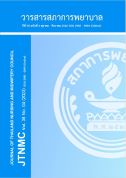Development of A Home Blood Pressure Monitoring-Based Self-Management Model in Patients with Hypertension and Uncontrolled Blood Pressure
DOI:
https://doi.org/10.60099/jtnmc.v38i04.265506Keywords:
home blood pressure monitor (HBPM), hypertension, self management, model developmentAbstract
Introduction Uncontrolled hypertension can result in severe complications, disabilities, and even death. Promoting patients to engage in self-management combined with home blood pressure monitoring is an approach to maintaining continuous control of their blood pressure.
Objective To develop and investigate the effects of a home blood pressure monitoring based self-management model in patients with hypertension and uncontrolled blood pressure.
Design This study is a Research and Development.
Methods The researchers developed a home blood pressure monitoring based self-management model for patients with uncontrolled blood pressure at a community hospital in a province of central region, Thailand. The development process was divided into four phases: 1) Problem analysis phase, examining issues with traditional care approaches; 2) Development phase, developing a self-management model integrated with home blood pressure monitoring; 3) Implementation phase, applying the developed model in patient care and evaluating outcomes; and 4) Adjustment phase, refining the self-management model and home blood pressure monitoring. Data were collected from December 2020 to December 2021, and were then analyzed using Paired t test.
Results The home blood pressure monitoring based self-management model included providing knowledge on hypertension, promoting appropriate practices on medication taking, food consumption, physical activity, and use of blood pressure monitoring tools including precise techniques for measuring blood pressure at home. A nurse conducted phone follow-ups in weeks 1, 2, and 4, with assessments scheduled in week 6 following the implementation of the model. Results revealed that patients’ medication taking behavior (M = 3.205, SD = 0.701) was significantly higher compared to the baseline (M = 2.562, SD = 2.144, t = -6.411, p < .001). Additionally, both systolic (M = 123.842, SD = 14.048) and diastolic (M = 76.122, SD = 12.206) blood pressure levels were significantly lower compared to the baseline (M = 135.303, SD = 11.037, t = 3.000 p = .045 and M = 85.221, SD = 9.903, t =4.864, p = .030, respectively). However, food consumption behavior (M = 11.312, SD = 0.890) and physical activity (M = 1.731, SD = 0.710) were not significantly different from the baseline (M = 11.153, SD = 0.839, t = -0.400, p > .05 and M = 1.710, SD = 0.756, t = 1.682, p > .05, respectively).
Recommendation The home blood pressure monitoring based self-management model helps enhance knowledge and self-management skills in the patients. This can serve as a model for care and monitoring of patients with uncontrolled hypertension, enabling them to effectively control their blood pressure. It involves designing home blood pressure monitoring tailored to individual needs.
Downloads
References
Unger T, Borghi C, Charchar F, Khan NA, Poulter NR, Prabhakaran D, et al. 2020 International society of hypertension global hypertension practice guidelines. Hypertension [internet]. 2020 [cited 2023 May 28];75(6): 1334-57. Available from: https://doi.org/10.1161/HYPERTENSIONAHA.120.15026
Suaeto N, Jirapoongsuwan A, Rawiworrakul T, Tipayamongkholgul M. The effect of a program to promote blood pressure control among 35 to 59 - years-old patients with uncontrolled hypertension. Journal of Public Health Nursing 2019;32(2):96-114. (in Thai)
Kaplan NM. Kaplan’s clinical hypertension. 8th ed. Philadelphia: Lippincott Williams & Wilkins; 2002.
Cohen S, Will TA. Stress, social support and the buffering hypothesis. Psychol Bull [internet]. 1985 [cited 2023 May24];98(2): 310-57. Available from: https://doi.org/10.1037/0033-2909.98.2.310
Ministry of Public Health. Health data center [internet]. 2015 [cited 2023 May28]. Available from: https://hdcservice.moph.go.th/hdc/main/index_pk.php (in Thai)
Thai Hypertension Society. 2019 Thai guidelines on the treatment of hypertension [internet]. 2019 [cited 2023 Feb10]. Available from: http://www.thaihypertension.org/hypertensiondetail.php?n_id=442 (in Thai)
Riegel B, Carlson B, Glaser D. Development and testing of a clinical tool measuring self-management of heart failure. Heart Lung 2000;29(1):4-15. doi: 10. 1016/s0147- 9563(00)90033-5 PubMed PMID: 10636953.
Eguchi K, Kuruvilla S, Ichikawa J, Schwartz JE. Pickering TG. A novel and simple protocol for the validation of home blood pressure monitors in clinical practice. Blood Press Monit 2012;17(5):210-3. doi: 10.1097/MBP.0b013e328356e196 PubMed PMID: 22797517.
Piaseu N. Statistical analysis and common problems. Thai Journal of Nursing and Midwifery Practice [internet]. 2016 [cited 2023 Feb10];3(2):83-9. Available from: https://he02.tci-thaijo.org/index.php/apnj/article/view/120358/91902 (in Thai)
Sumthong P, Suthiphongkirt B, Kleebpratoom, Oadpakdee W. The effect of home blood pressure monitoring program applying transtheoretical model and social support power in hypertensive patients, Angthong hospital. Journal of Prachomklao College of Nursing Phetchaburi province [internet]. 2019 [cited 2023 March11]; 2(1):1-14. Available from: https://he01.tci-thaijo.org/index.php/pck/article/view/186033/130734 (in Thai)
Krejcie RV, Morgan DW. Statistics determining the sample size for research [internet]. 1970 [cited 2023 March11]. Available from: http://www.home.kku.ac.th/sompong/guest_speaker/KrejcieandMorgan_article.pdf.
Iamsuphasit S. Theories and techniques in behavior modification. 10th ed. Bangkok: Chulalongkorn Press; 2022.
Montrivade S, Chattranukulchai P, Siwamogsatham S, Vorasettakarnkij Y, Naeowong W, Boonchayaanant P, et al. Hypertension subtypes among Thai hypertensives: An analysis of telehealth-assisted instrument in home blood pressure monitoring nationwide pilot project. Int J Hypertens 2020 Apr 9:2020:3261408. doi: 10. 1155/2020/3261408. PubMed PMID: 32328300
Imai Y, Kario K, Shimada K, Kawano Y, Hasebe N, Natsyyra H. et al. The Japanese society of hypertension guidelines for self-monitoring of blood pressure at home (Second edition). Hypertens Res 2012;35(8): 777-95. doi: 10.1038/hr.2012.56. PubMed PMID: 22863910.
Jeanagool P, Sabaisook S, Kongkaew S, Wimonsinrapin P, Luelarb P, Kramkeaw T, et al. Clinical performance and quality of care for patient with ST-Elevation myocardial infarction at the emergency department in central chest institute of Thailand. Journal of the Department of Medical Services [internet]. 2019 [cited 2023 March11];44(6):77-84. Available from: https://he02.tci-thaijo.org/index.php/JDMS/article/view/244798/166408
O’Keefe EJ, Berger DS. Self-management for College Student: the ABC approach. 3rd ed. New York: Partridge Hill Publishers; 1999.
Downloads
Published
How to Cite
Issue
Section
License
Copyright (c) 2023 The Journal of Thailand Nursing and Midwifery Council

This work is licensed under a Creative Commons Attribution-NonCommercial-NoDerivatives 4.0 International License.








